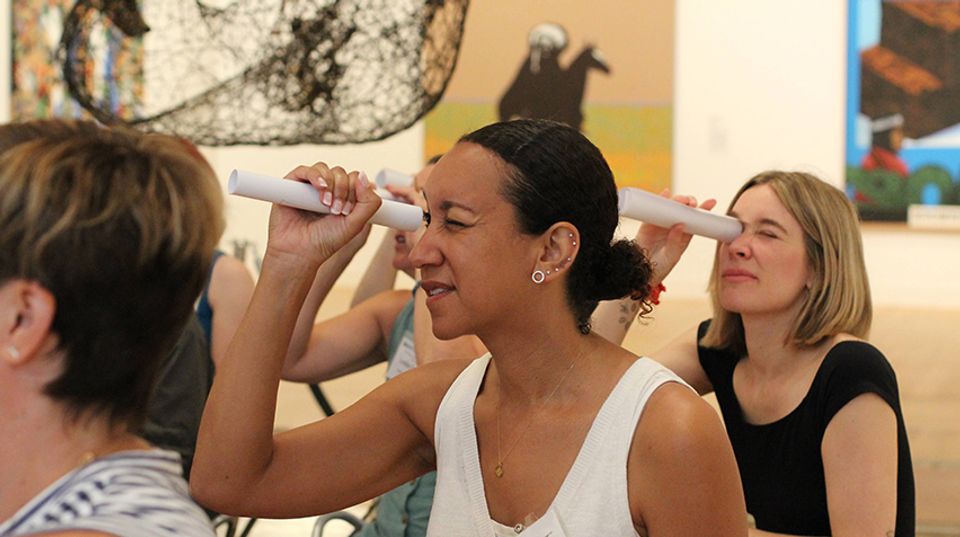
Alexis Rockman, Kapok Tree, 1995, Oil on wood, Haggerty Museum of Art, Marquette University, Milwaukee, Gift of Peter Norton, © Alexis Rockman Photo courtesy of the artist
Christopher Kendall, Dean and Paul Boylan Collegiate Professor of Music of the University of Michigan School of Music, Theatre & Dance, leads the musical ensemble, 21st Century Consort, which is in residence at the Smithsonian American Art Museum, in a concert Saturday, February 12, 2011. Prelecture is at 4:00 and the concert at 5:00. Tickets are $20 at residentassociates.org, by calling 202 633 3030, or at the door. Jo Ann Gillula, Chief of External Affairs at American Art asked Christopher about the upcoming concert.
Eye Level: We have had a wonderful reaction to our current exhibition, Alexis Rockman: A Fable for Tomorrow, which inspired this upcoming concert. As you know, Rockman explores environmental issues with clarity and wit. His deep concerns about the world's fragile ecosystems and the tension between nature and culture inform his work. Are there any musical corollaries you can make with the works in the concert?
Christopher Kendall: We did a program last season entitled "Flora and Fauna" that got me thinking about music inspired by plants and animals. This concert is a "return of the flora and fauna," only with repertoire that adds a dimension of the fantastic, reflecting Rockman's artistic vision.
EL: Although in many of his artworks, Rockman combines both the imagined as well as real creatures, on his first trip to Guyana, he determined to faithfully execute what he saw, almost in a botanical illustration tradition, though his scale or his perspective is sometimes imaginary. Do any of the works in the program speak to imaginary flora or fauna or do they make a more realist reference?
CK: We have a work with fleeting reference to a leaf, and another actually called "Imaginary Animals." The "Cowbird Quartet" is quite literal, in a jokey way, in its depiction of a cow and a bird...and a cowbird. I find that it generally doesn't pay to be too literal in identifying music related to visual art; rather it is stimulating, illuminating, and often fun to let the associations fly free.
EL: I believe this concert gathers together some of the longtime favorite performers of the 21st Century Consort for one piece which is especially ambitious and which requires a larger number of musicians. Can you give us a hint of what we can look forward to and why this is so unusual?
CK: Jacob Druckman's "Lamia" is for a larger ensemble than we usually attempt to fit on the McEvoy stage. Lucy Shelton, one of the great interpreters of contemporary vocal music, is the soprano soloist in this mysterious but intensely theatrical work. There is something almost apocalyptic about the piece, and in this it may express the ultimate concern in Rockman's ideas about the fragility of the environment.
EL: Because Alexis Rockman grew up wandering the halls of the American Museum of Natural History in New York City where his mother worked, he has always been fascinated with the concept of dioramas. In fact, a hallmark of his work would be three layers which are usually distinctive: the horizon line dividing the earth or water and the sky, and also a line dividing the top of the ground or water from what lies beneath. In addition, his work depicts that “underlayer” quite vividly, and in fact, sometimes ominously. Are there any musical pieces which you would characterize as having these various layers, either in the way they are constructed or in the combination of music and lyrics?
CK: Stravinsky's "Rite of Spring" is built in sonic blocks and layers. In the version we're doing on this concert, "Rite" is performed on one piano by two pianists. The work, of course originally a ballet, requires exquisite choreography from the two players to navigate the keyboard in this fiendishly difficult music. When Disney got through with "Rite," many see dinosaurs when they hear the music; how Rockman is that?
EL: Rockman utilizes a strong palette of vivid colors in all of his works, whether it is his "big weather" series or his imagined degradation of American national monuments overtaken by climate change. How does this concert underline various colorations by your chosen composers?
CK: The varied scorings heard on the program, different in each work, could be seen as providing a kaleidoscope of colors, ranging from the big palette offered by the large ensemble in "Lamia" to the effusion of electronic "colors" of the electronic "Imaginary Animals." At the same time, it is fascinating to consider the matter of color in relation to a performance of the "Rite of Spring" on a piano instead of the vast forces of the orchestral version. Not thinking of the piano keys, but of color, would it be correct to consider this a black and white version of the "full color" scoring for orchestra?
EL: Rockman is very much a contemporary artist, but his mastery of color and line often hearken back to realist art traditions as old as the Renaissance. Can you draw any similarities with one of the composers we will be hearing?
CK: Perhaps not the Renaissance, but Bruce MacCombie's poignantly beautiful "Light Upon the Turning Leaf" and Paul Schoenfield's whimsical "Cowbird Quartet" both make full use of tonal materials, which one could consider a kind of musical equivalent of realism in art.

















